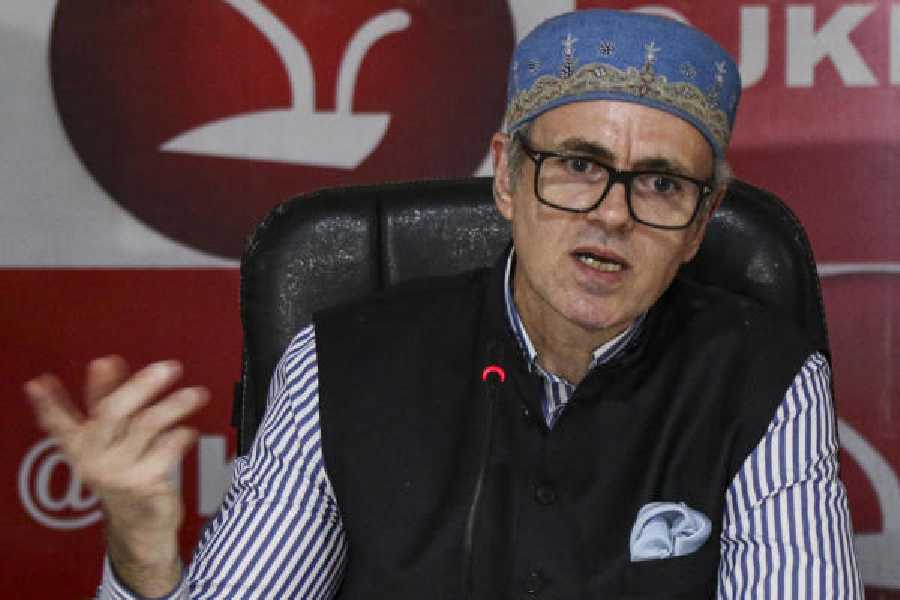 |
| Wajid Ali Khan's lost portrait |
Metiabruz is an epitaph to Wajid Ali Shah, the last nawab of Oudh. Yet this hinterland of Calcutta has today obliterated all memories of the deposed ruler who created a beautiful and bustling township there after he was released from house arrest by the British at Fort William. Garden Reach Road has been renamed after the king. That is about all.
The echoes of the poetic names this colourful ruler gave to places of worship, palaces and bungalows he constructed there in the latter half of the 19th century, have died down. The pleasances and land were all sold off for a pittance soon after his death on September 21, 1887. Only the large Sibtainabad Imambara on Garden Reach Road, Baitul Naajat, another smaller imambara a few yards away named Quasrul Buka, and Shahi Masjid, the nawab’s personal chapel, have survived.
Besides Abdul Halim Sharar’s eyewitness account of Metiabruz in the nawab’s time in his invaluable book Lucknow: The Last Phase of an Oriental Culture, there is photographic and documentary evidence of the beauty of the township, the noble buildings and the zoo he built. These documents are in the possession of Amjad Ali Mirza, a great-great-grandson of the king. Struggling for survival himself, he is hard put to preserve this portfolio of friable sepia prints. In his 60s, he has two young sons and a married daughter.
Metiabruz is a maze of lanes lined with slums and mean dwelling houses. Instead of cool fountains and gardens, huge open drains course through piles of garbage. This used to be gangland till not so long ago, and one remembers with a shudder the terrifying death of Vinod Mehta, an upright police officer, in the alleyways of Metiabruz on March 18, 1984.
The postcard-sized sepia prints of Amjad Ali Mirza conjure up a Metiabruz transformed by magic. Palaces have replaced shanties, and gardens have grown in place of slushy lanes. The photographs were handed down to Mirza by his uncle Yaqub Ali Mirza, who died in 1973.
In Metiabruz, the nawab committed no act that the strictest religious codes would not have approved. His comfort women were all his wives, even if temporary ones. The only passions he indulged in were architecture and collecting animals for his zoo, notwithstanding his very limited income. These cool, stately and luxurious dwelling houses stood amidst wide expanses of water, lawns with groves or on the Hooghly banks. The other marvel of Metiabruz was the king’s zoo. He bought white peacocks and pigeons for fabulous sums. Separate enclosures were built for wild animals.
Amjad Ali Mirza has the photocopy of a handwritten legal document detailing the nawab’s estate at the time of his death. The moth-eaten original is missing, but at the end of the inventory the following words are written: “The areas Government Revenue and Holding Nos are taken from Report submitted by the Alipore Collectorate Surveyor under orders of the collector. The Report is based upon the survey recently made by the surveyor. Inspection of the Title deeds and plans can be had at the office of the undersigned. Solicitor to Government and Agent under Act XIX of 1887”. The marble-floored buildings with adjoining tanks named here such as Asad Manzil, Noor Manzil, Radha Manzil and Morassa Manzil corroborate Sharar’s account. The king’s menagerie, stables, dovecotes and aviary, too, figure here.
In the early Eighties, when I first visited Metiabruz, Prince Anjum Quder, grandson of Birjis Quder, Wajid Ali Shah’s eldest surviving son, was alive. When I went back to Metiabruz recently, his son, Burhan Ali Meerza, took me around. Now Anjum Quder’s brother, Prince Nayyer Quder, is chairman of the trust. The prince has another brother, Dr Kaukub Quder.
On my first visit, Prince Anjum Quder had said that the nawab used to meditate for hours at Sibtainabad Imambara during Muharram. It was built in 1864 and stands impervious to the crowds and vehicles on Garden Reach Road. The king and other family members were interred here.
At that time I had met Manindra Nath Ghosh, already an old man, who had muddled memories of the zoo. Wajid Ali Shah had gathered at Metiabruz a large number of talented artists, musicians, courtesans, calligraphers and renowned hakims and theologians, besides keepers of his zoo and menials. The refinement of speech and manners, for which Metiabruz became famous, albeit for a short while, owed itself to their presence. Ghosh’s great-grandfather was a guard to whom the king had gifted a plot of land, later misappropriated. At the time of Muharram he would create a Jao-ka Tazia with barley sprouts grown on a bamboo frame that would be taken out with the tazia procession. Manindrababu’s family has handed over the tazia to a Muslim family. But thousands of devotees of all communities still come with their offerings during Muharram — a symbol of the king’s religious tolerance.
The 1992 post-Babri Masjid riots have left their mark on Metiabruz. Earlier, I had met Motilal Srimali, a descendant of the famous Shahi Paanwalas. Motilal has died and the painting of the young king on a steed on the banks of a river that used to be prominently displayed was looted. His son Ramesh Kumar Saini has taken over his paan shop. Wajid Ali Shah is still present as a fop in a peekaboo angrakha.
Burhan Ali Meerza and Hasan Naqvi, whose ancestor was a high priest in the Oudh court and who is a trade union leader himself, took me to the bijou Shahi Masjid on Iron Gate Road, once part of the king’s palace complex. Its narrow entrance is squeezed between high factory walls. The cockscomb-like stucco ornament on the mosque roof is in perfect harmony with its elegant proportions. The palace, Sultan Khana, used to stand behind this. The grounds could do with some nurturing. Nature has an overpowering presence here, and if not uprooted, weeds may overrun the place.
We went down a flight of stairs next to Bichalighat, opposite the Botanical Gardens. From the bank a few yards away, the Calcutta skyline is visible as the river takes a turn. The king’s personal imambara, Baitul Naajat, cheek-by-jowl with a sawmill is whitewashed. But many of the stucco pineapples around the terrace, a trademark of Lucknow architecture, have toppled over. We went to the zenana imambara, Quasrul Buka, whose courtyard is alive with the honking of geese.
Burhan Ali Meerza pointed out Tukra Patti, a marketplace, which a signboard claims dates back to 1886. We walked into a squalid lane. That being the second day of Holi, boisterous young men were busy smearing each other’s faces with colours. This was Ata Bagh, another royal bungalow, now made over into a godown. The pillars are the only indicators of its noble lineage. We went deeper into the shantytown. I was told that the royal stable stood here. Cycle-rickshaws will bring you straight to this place if you say your destination is the Shahi Astaabal.










